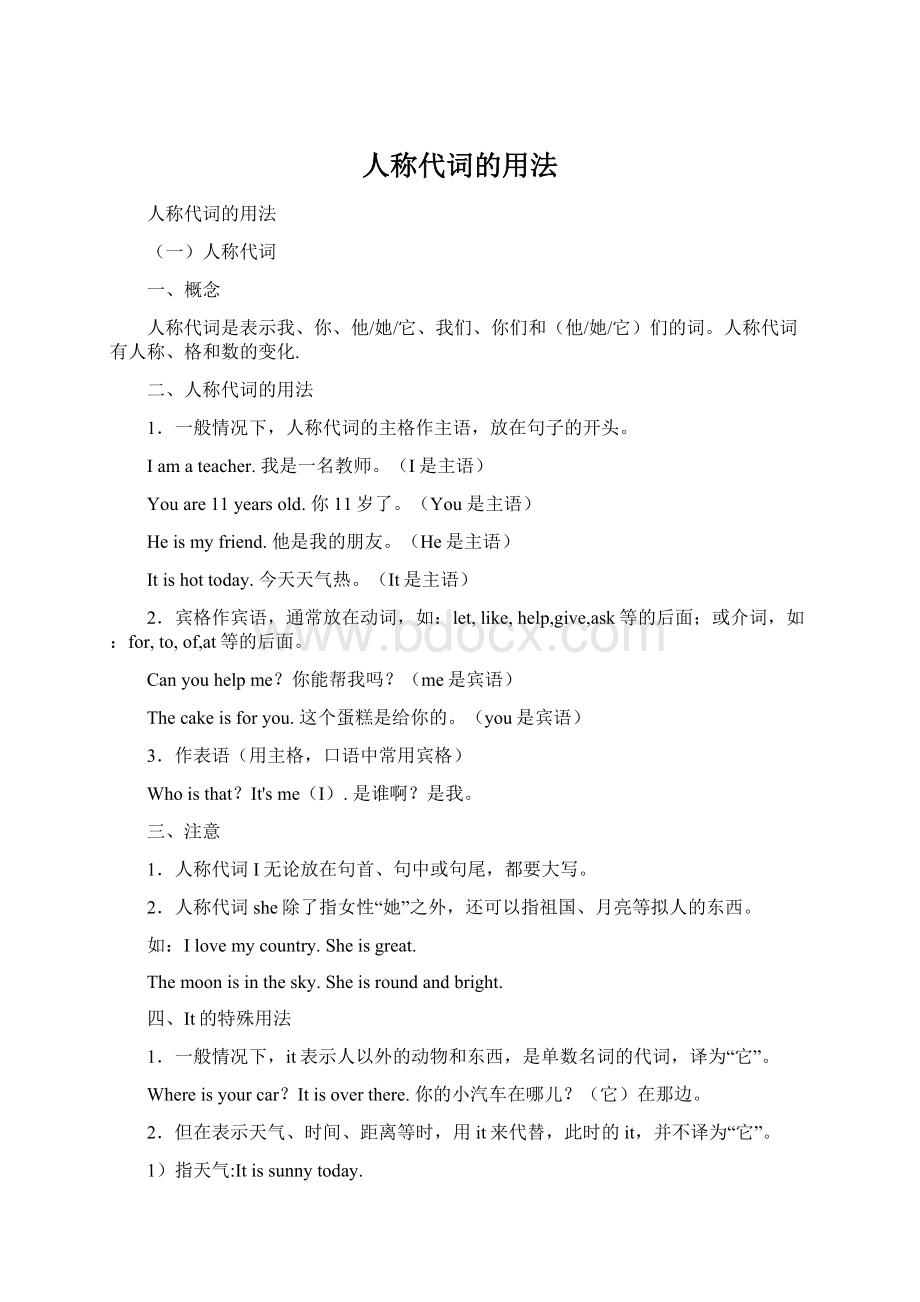人称代词的用法.docx
《人称代词的用法.docx》由会员分享,可在线阅读,更多相关《人称代词的用法.docx(10页珍藏版)》请在冰豆网上搜索。

人称代词的用法
人称代词的用法
(一)人称代词
一、概念
人称代词是表示我、你、他/她/它、我们、你们和(他/她/它)们的词。
人称代词有人称、格和数的变化.
二、人称代词的用法
1.一般情况下,人称代词的主格作主语,放在句子的开头。
Iamateacher.我是一名教师。
(I是主语)
Youare11yearsold.你11岁了。
(You是主语)
Heismyfriend.他是我的朋友。
(He是主语)
Itishottoday.今天天气热。
(It是主语)
2.宾格作宾语,通常放在动词,如:
let,like,help,give,ask等的后面;或介词,如:
for,to,of,at等的后面。
Canyouhelpme?
你能帮我吗?
(me是宾语)
Thecakeisforyou.这个蛋糕是给你的。
(you是宾语)
3.作表语(用主格,口语中常用宾格)
Whoisthat?
It'sme(I).是谁啊?
是我。
三、注意
1.人称代词I无论放在句首、句中或句尾,都要大写。
2.人称代词she除了指女性“她”之外,还可以指祖国、月亮等拟人的东西。
如:
Ilovemycountry.Sheisgreat.
Themoonisinthesky.Sheisroundandbright.
四、It的特殊用法
1.一般情况下,it表示人以外的动物和东西,是单数名词的代词,译为“它”。
Whereisyourcar?
Itisoverthere.你的小汽车在哪儿?
(它)在那边。
2.但在表示天气、时间、距离等时,用it来代替,此时的it,并不译为“它”。
1)指天气:
Itissunnytoday.
今天阳光灿烂。
2)指气候:
It'scoldinthisroom.
这个房间很冷。
3)指时间:
Whattimeisit?
It'ssixthirty.
几点了?
六点半了。
4)指距离:
Howfarisitfromheretothepark?
从这儿到公园有多远?
It'sabouttwomiles.
大约是二英里。
五、人称的习惯顺序:
介词ThePreposition(prep)表示名词、代词等和句中其他词的关系From,with,at,into,behind,between,for
连词TheConjunction(conj)用来连接词与词、短语与短语或句与句And,or,but,so,because
感叹词TheInterjection(interj)表示说话时的喜悦、惊讶等情感Oh,hey,ouch,well,there,dear
下面是一些比较典型的“陷阱”题目,请大家做做看:
1.Mr.Wangmadeuphismindtodevoteallhecould_hisoralEnglishbeforegoingabroad.
A.improveB.toimproveC.improvingD.toimproving
2.Everythinghe--awayfromhimbeforehereturnedtohishometown.
A.tookB.hadbeentakenC.hadhadbeentakenD.hadtaken
3.Beforehewentabroad,hespentasmuchtimeashe--English.
A.couldlearningB.learnedC.tolearnD.couldlearn
4.YoucanneverimaginewhatgreatdifficultyIhave_yourhouse.
A.foundB.findingC.tofindD.forfinding
5.Thepersonwespoketo_noansweratfirst.
A.makingB.makesC.makeD.made
6.Thepersonwereferredto(提及)_usareporttomorrow.
A.givingB.willgiveC.gaveD.give
7.Thedayswehavebeenlookingforwardto()soon.
A.comingB.willcomeC.cameD.havecome
8.Thepersonwetalkedabout()ourschoollastweek.
A.visitingB.willvisitC.visitedD.hasvisited
9.Themanwhosesongswearefondof()inourcitynextweek.
A.singingB.tosingC.willsingD.sang
10.Notonly_thejewelryshe()beensoldforherson'sgamblingdebtsbutalsoherhouse.
A.is;hasB.has;hadC.has;hasD./;has
11._inthought,healmostranintothecarinfrontofhim.(NMET96)
A.LosingB.HavinglostC.LostD.Tolose
12.Theresearchissodesignedthatonce_nothingcanbedonetochangeit.(NMET2002)
初中英语重要句型
assoonas
as…as…
as…aspossible
asksb.forsth.
ask/tellsb.(how)todosth.
ask/tellsb.nottodosth.
beafraidofdoingsth./that…
初中英语重要句型
8.bebusydoingsth.
9.befamous/late/ready/sorryfor…
10.begladthat…
11.buy/give/show/bring/lend/send/pass/
tell…sthtosb.
12.buy/give/show/send/pass/bring/lend/
tellsb.sth.
初中英语重要句型
13.either…or…
14.enjoy/hate/like/finish/stop/mind/keep/
goondoingsth.
15.findit+adj.todosth.
16.get+比较级
17.getreadyfor/getsth.ready
18.hadbetter(not)dosth.
初中英语重要句型
19.helpsb.(to)do/helpsb.with…
20.Idon'tthinkthat…
21.Iwouldliketo/Wouldyouliketo..
22.isoneofthe+最高级+名词复数
23.Itis+adj.forsb.todosth.
24.Itisagoodideatodosth.
25.Itisthesecond+最高级+名词
初中英语重要句型
26.Itlookslike…/Itsoundslike…
27.Itseemstosb.that…
28.Itsounds+adj./Itlooks+adj.
29.Ittakessb.sometimetodosth.
30.It'sbad/goodfor…
31.It'stimefor…/todosth.
32.It'stwometers(years)long(high,old)
初中英语重要句型
33.keepsb.doingsth.
34.liketodo/likedoingsth
35.keep/makesth.+adj.
36.make/letsb.(not)dosth.
37.neither…nor…
38.not…atall
39.not…until…
初中英语重要句型
40.One…theother…/Some….others…
41.prefer…to…
42.see/hearsb.do(doing)sth.
43.so…that…
44.spend…on/(in)doingsth.
45.stoptodo/stopdoingsth.
46.sucha(an)+adj.+n.that…
初中英语重要句型
47.take/bringsth.withsb.
48.thanksb.forsth.
49.Themore…themore…
50.Thereissomethingwrongwith…
51.too…to…
52.usedto…
53.Whatabout/Howabout…
初中英语重要句型
54.What'sthematterwith…
55.What'swrongwith…
56.Whynot…
57.Will(Would,Could)youplease…
初中英语八种时态归纳复习
1.一般现在时:
主语+do/does(现在分词)Wecleantheroomeveryday.
一般现在时:
do(n't)/does(n't)
2.一般过去时:
主语+didWecleanedtheroomjustnow.
一般过去式:
did(n't)+V.原
3.现在进行时:
主语+am/is/aredoingWearecleaningtheroomnow.
现在进行时:
am(not)/is(n't)/are(n't)+V.ing
4.过去进行时:
was/weredoing.Wewerecheaningtheroomat5:
00yesterdayafternoon.
过去进行时:
was(n't)/were(n't)+V.ing
5.现在完成时:
have/hasdoneWehavecleanedtheroomalready.
现在完成时:
have(n't)/has(n't)+过去分词(p.p.)
6.过去完成时:
haddoneWehadcleanedtheroombeforehearrived.
过去完成时:
had+p.p.
7.一般将来时:
willdo/Wewillcleantheroomtomorrow.
一般将来时:
will(not)+V.ing/is(n't)/are(n't)+goingto+V.原
8.过去将来时:
was/wereto/woulddoHesaidhewouldcleantheroomnext
过去将来时:
would(n't)/was(n't)/were(n't)+V.原
动词不定式:
to+V.ing
一、一般现在时:
概念:
经常、反复发生的动作或行为及现在的某种状况。
时间状语:
often,usually,always,sometimes,everyweek(day,year,month...),onceaweek,onSundays,etc.
基本结构:
①be动词;②行为动词
否定形式:
①am/is/are+not;②此时态的谓语动词若为行为动词,则在其前加don't,如主语为第三人称单数,则用doesn't,同时还原行为动词。
一般疑问句:
①把be动词放于句首;②用助动词do提问,如主语为第三人称单数,则用does,同时,还原行为动词。
二、一般过去时:
概念:
过去某个时间里发生的动作或状态;过去习惯性、经常性的动作、行为。
时间状语:
ago,yesterday,thedaybeforeyesterday,lastweek(year,night,month...),in1989,justnow,attheageof5,oneday,longlongago,onceuponatime,etc.
基本结构:
①be动词;②行为动词
否定形式:
①was/were+not;②在行为动词前加didn't,同时还原行为动词。
一般疑问句:
①was或were放在句首;②用助动词do的过去式did提问,同时还原行为动词。
三、现在进行时:
概念:
表示现阶段或说话时正在进行的动作及行为。
时间状语:
now,atthistime,thesedays,etc.
基本结构:
am/is/are+doing
否定形式:
am/is/are+not+doing
一般疑问句:
把be动词放在句首
四、过去进行时:
概念:
表示过去某段时间或某一时刻正在发生或进行的行为或动作。
时间状语:
atthistimeyesterday,atthattime或以when引导的谓语动词是一般过去时的时间状语等。
基本结构:
was/were+doing
否定形式:
was/were+not+doing
一般疑问句:
把was或were放在句首
五、现在完成时:
概念:
过去发生或已经完成的动作对现在造成的影响或结果,或从过去已经开始,持续到现在的动作或状态。
时间状语:
recently,lately,since...,for...,inthepastfewyears,etc.
基本结构:
have/has+done
否定形式:
have/has+not+done
一般疑问句:
have/has放于句首
六、过去完成时:
概念:
以过去某一时间为标准,在此以前发生的动作或行为,或在过去某动作之前完成的行为,即“过去的过去”。
时间状语:
before,bytheendoflastyear(term,month...),etc.
基本结构:
had+done
否定形式:
had+not+done
一般疑问句:
had放于句首
七、一般将来时:
概念:
表示将要发生的动作或存在的状态及打算、计划或准备做某事。
时间状语:
tomorrow,nextday(week,month,year....),soon,inafewminutes,by...,thedayaftertomorrow,etc.
基本结构:
①am/is/are/goingto+do;②will/shall+do
否定形式:
①am/is/are+not+goingto+do;②will/shall+not+do
一般疑问句:
①be放于句首;②will/shall提到句首
八、过去将来时:
概念:
立足于过去某一时刻,从过去看将来,常用于宾语从句中。
时间状语:
thenextday(morning,year...),thefollowingmonth(week...),etc.
基本结构:
①was/were/goingto+do;②would/should+do
否定形式:
①was/were/not+goingto+do;②would/should+not+do
一般疑问句:
①was或were放于句首;②would/should提到句首
句型
(一)
such+名词性词组+that…
So+形容词/副词+that…——如此……以致……
例如:
(1)Sheissuchagoodteacherthatweallloveher.她是一个好老师,我们都爱她。
(2)Itwassuchahotdaythattheydidn’tgooutforawalkasusual.这么热的天气,他们没有像往常一样去散步。
注意点:
1.such+a+形容词+名词+that…,可以改写成:
so+形容词+a+名词+that…,例句
(1)可以改写成:
Sheissogoodateacherthatweallloveher.
2.在such+形容词+名词复数或不可数名词+that…结构中,形容词如果是many/few或much/little时,用so不用such,即:
so+many/few+可数名词复数+that…,so+much/little+不可数名词+that…
(1)TherearesomanypeopleintheroomthatIcan’tgetin.房间里人太多,我进不去。
(2)Themanhassomuchmoneythathecanbuyacar.那人很有钱,他能买一辆小汽车。
句型
(二)
Therebe…,either…or…,neither…nor…,notonly…butalso…
例如:
(1)Thereisapenandtwopencilsinhispencil-box.他的铅笔盒里有一支钢笔和两支铅笔。
(2)NotonlyyoubutalsoIhavebeentotheGreatWall.你和我都没有去过长城。
(3)EitheryouorIamleavingforShanghai.要么你去上海,要么我去上海。
(4)Neitheryounorheisright.你和他都不对。
(5)BothJackandTimareEnglish.
Jack和Tim是英国人。
注意点:
当这几个句型连接主语时,谓语动词的人称和数要考虑“就近原则”,对比both…and…来记忆,both…and…连接主语时视为复数。
句型(三)
Enough+名词+todo…——有足够的……做某事
形容词/副词+enough+todo…——足够……做某事
例如:
(1)Thereisenoughroomtoholdthesepeopletohaveameeting.有足够的地方容下这些人开会。
(2)Theboyisstrongenoughtocarrytheheavybox.这个男孩力气够大,能搬动这只箱子。
注意点:
enough做副词修饰形容词或副词时,放在所修饰词的后面,句子可以用so…that…句型改写。
例句
(2)可以改写为:
Theboyissostrongthathecancarrytheheavybox.这个男孩力气很大,能搬动这只箱子。
句型(四)
too+形容词/副词+todo…——太……以致不能……
例如:
(1)Iwastooexcitedtosayaword.我激动得一个字也说不出